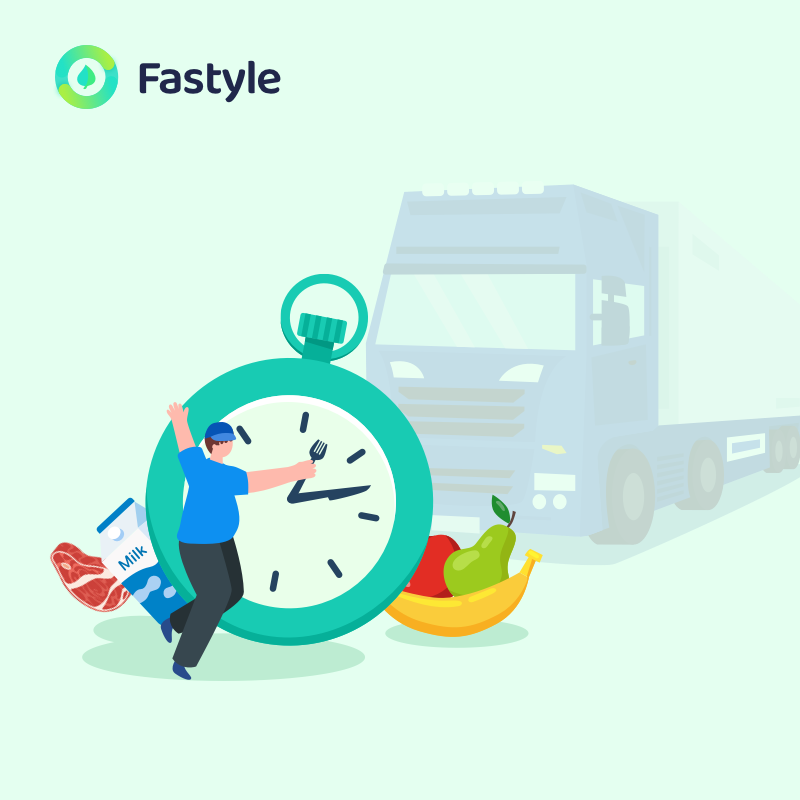Shift work is more common nowadays not only in public services such as health care and law enforcement but also in customer services and hospitality. What your working schedule looks like is key when it comes to choosing an intermittent fasting regime. It is certainly more difficult to choose from the regular fasting plan for shift workers compared to 9-5ers. This article will talk you through some key issues with shift workers and how to choose a suitable fasting plan.
About Shift Works
Shift work typically refers to any schedule outside of the period of 7 AM to 6 PM. Shift workers sometimes work longer hours shifts that are >8.5 hours/>40hours/week as part of a compressed schedule. Some typical shift workers include:
- Law enforcement
- Healthcare workers, such as nurses and doctors
- Nursing homes
- Emergency services & hotlines
- Security
- Customer service and call centers
- Factories and warehouse
- Restaurants and hospitality
- Grocery stores, convenience stores, and bodegas
- Bartending
- Transportation like truckers or Uber drivers.
Shift Work & Circadian Rhythm
There are certainly some advantages of shift work, such as getting a day off on weekdays, avoiding peak hours during commutes, and higher pay. However, shift work, especially night shifts, have a working schedule that contradicts with the natural circadian rhythm, which disrupts the body’s homeostasis (the balance system your body try to maintain) and increases the risk for several health conditions, including
- Cardiovascular disease
- Insomnia
- Gastrointestinal problems
- Diabetes & difficulty managing chronic diseases
- Obesity
- Heart Attack
- Psychological disorders
- Some cancer
- Sleep disorder, excessive sleepiness
- Insomnia
- Irritability
- Depression
- Lack of energy
- headaches
Circadian rhythms are internally driven cycles of biochemical, physiological, and behavioral processes of living beings that rise and fall across the 24-hour day. It helps to regulate sleepiness and wakefulness, influences important functions in our body, such as hormone release and eating habits, and digestion.
You can rebuild a disrupted circadian rhythm by structuring the day around your shift schedule. Intermittent fasting alerts between fasting and eating windows, which is like cycling between sleep and awake time. Selecting an intermittent fasting plan based on your shift work schedule can help you to maintain a circadian rhythm and adjust to your shift work schedule much quicker.
Planning your Intermittent Fasting
For shift workers, the circle might work differently for 9-5ers. Therefore, matching an IF regime with a shift worker’s work schedule can help to rebuild your own circadian rhythm.
How to plan your fast is just the same as everybody else, and here is a basic step-by-step guide to help you choose a fasting plan.
Step 1. Choose a plan
This can be 14:10 or 16:8 to start with, then slowly build up the intensity if you need to. The longer the fasting window, the more intense the fasting plan is.
Step 2. Set your “START” & “END“ time (fasting & eating window)
Here are some things to consider as you set your windows:
- Pick a wake-up time so that you can get to work soon.
- Do you work a busy shift? It is better to fast during a busy shift.
- When do you feel most hungry? It is best to include that time in your eating window.
- Your access to food. Do you need to prepare your own food, or do you buy food? If you planned an eating window in the midnight or early morning, you may have to prepare your own food.
- If in doubt, ask your Coach within the Fastyle app.
Step 3. Plan your meals during the eating window
You must choose how many meals and when you have them. This can help you stick to the routine and eating window much easier while on a non-regular shift schedule. Aim for 2 main meals and 1-2 snacks. Generally, space your meals 2-3 hours apart, and finish eating at least 3-4 hours before your bedtime.
Here are some examples of three types of shift work schedules using a 16:8 fasting plan.
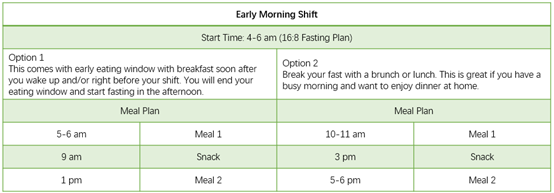

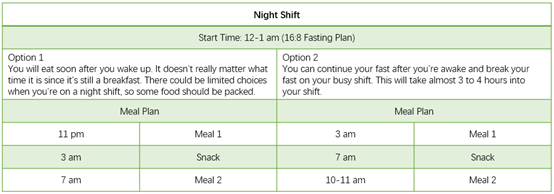
If these three options aren’t right for you, you can follow the steps introduced above to customize your own plan. This will work for any fixed shift outside those three options.
Here is an example of a night shift:
- Choose an intermittent fasting plan like the 16:8 regime.
- Eating window: 12 am – 8 am; Fasting window: 8 am – 12 am
- Start shift: 9 pm, and wake up time: 7-8 pm
- Yes, I will fast during my shift till “lunch”.
- I’m most hungry around 1-2 am and start eating window from 12 am – 8 am.
- Prepare food or buy food in advance for the night shift, and cook meals after shifts.
- Meal plan
- Meal 1 – 12 am
- Snack 1 – 3 am
- Snack 2 – 6 am
- Meal 2 – 8 am
Shift Work and Sleep
Circadian rhythms have an important purpose: they prepare your body for expected changes in the environment and, for example, the time for activity, time for sleep, and time to eat. Sleep is an important part of our body. Shift work often influences sleeping patterns with a disrupted circadian, leading to the following syndromes:
- compromised immune function
- disrupted insulin/blood glucose system
- promoting insulin resistance
- unbalanced appetite hormones promoting overeating and obesity
- impaired mental functioning, feeling anxious, irritated, or depressed
A night-shift worker is likely most affected among these three types of shifts (early morning, afternoon, and night shift). Sleep is the result of a balance between sleep pressure and wakefulness. When your sleep pressure stays over wakefulness, you will fall asleep. And wake up when wakefulness over sleep pressure.
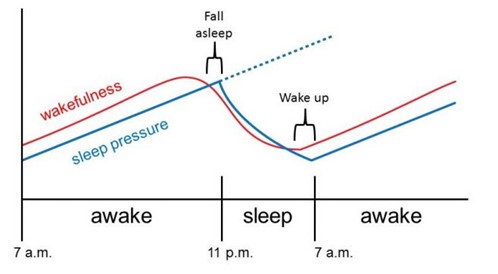
This will be a problem with a night shift worker if the circadian system has not adjusted to working at night and sleeping during the day. The sleep pressure drives and circadian rhythms for wakefulness will not be synchronized and, as a result, will not work together. You may feel sleepy at work because your sleep pressure stays over your wakefulness.
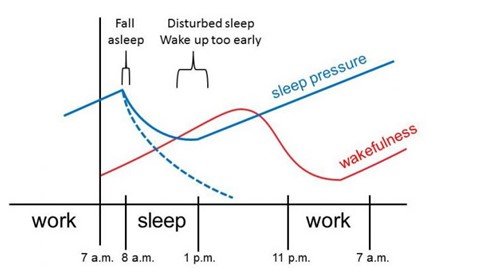
So how do you adjust your sleeping time for synchronization?
In general, it is easier to change sleep times by getting up later or sleeping later than getting up earlier. This is because the circadian pacemaker tends to run longer than 24 hours, which makes it easier to sleep later.
To change sleep times to get up or go to bed earlier. The key is to initiate an external timing cue for the rhythm pacemaker within your body to promote sleepiness. The light/dark cycle of the sun is the strongest cue and strategy to minimize what can keep you up:
- Make the bedroom dark
- Create a good sleep environment
- Block out noise
- Keep bedroom’s temperature down
- Use a comfortable mattress and pillows
- Avoid watching TV, reading, or working in the bedroom
- Turn the clock face away
- Avoid blue light (electronic devices)
- Avoid daytime nap
- Avoid caffeine 5-6 hours before bedtime
- Avoid alcohol several hours before bedtime (Can you drink alcohol during intermittent fasting? Here comes an answer)
- Avoid heavy, spicy meals 2-3 hours before bedtime
- Avoid nicotine, several hours before bedtime
- Regular exercise during the daytime
- Use sleeping aids, such as melatonin
Other tips for intermittent fasting on shift work.
What should you eat?
When it comes to what to eat during intermittent fasting, we recommend general healthy eating guided by the Dietary Guidelines for Americans and ratio your meals with the MyPlate model by the USDA. You may also follow other healthy diets if needed such as the Mediterranean Diet, Flexitarian Diet, and different types of vegetarian diets.
What about a day off?
Your body works best when you get up at about the same time every day. If you are on a fixed shift schedule, you can pick an awake time to get to work soon on your working days. Then get up at the same time on the weekend. If you have worked on different shifts, it is better to go to bed earlier on working days or take a nap to catch up on lost sleep during the weekend.
Adjust your fasting & eating window
Sometimes you may need to adjust your fasting and eating windows during the week to match your shift work. The easiest way to do this and avoid affecting your results is to extend or shorten your fasting and eating window by several hours and then resume your regular plan the next day. The key principle is to meet a minimal fasting time of 12-14 hours each day such as in the image below:
Meanwhile, stick to your meal plan (how many meals you will have in a day) to avoid overeating when you’re adjusting your windows.
Top 5 Intermittent Fasting Apps Fit for Shift Workers
SoonFasting: Best for Those that Tend to Give Up Easily
- iOS Rating: 4.8
- Android Rating: 4.8
- Download: Free
- Use: Partially free
- Price: Basic features can be used with no subscriptions.
What is the most effective fasting strategy? The plan that best suits you is the best plan for you. Soon creates customized fasting plans based on your goals, weight, eating habits, daily schedule, and overall health.
Don’t know what to do? Follow the app’s instructions. All of the tools are so simple to use that you won’t have to think or remember anything. You will receive all of the information you require when you require it.
Are you having difficulty losing weight? Soon-the app will help you. More than ten professionals with years of experience will help you achieve your objective.
Key Features
- Calorie Counting: No
- Friendly to Share with Friends: Soon keeps itself easily shared with others and the content on this app and a user’s fasting plan can be shared with friends without effort.
- Diet Suggestions: Yes. Soon provides professional diet suggestions during the eating window and real MyPlate diet recipes.
BodyFast: Best for Pro Fasters
- iOS Rating: 4.7
- Android Rating: 4.7
- Download: Free
- Use: Partially free
- Price: Getting the BodyFast Coach will give you access to even more features. Pricing varies, but one month for $27.23 per week, three-month for $19.72 per week, and yearlong options for $9.38 per week are available.
With over 23 million downloads, this German-based IF software allows you to switch the sort of fast you’re on a regular basis, depending on your objectives and needs for the day or week. Weekly challenges and trophies are also available to keep you motivated. The number of fasting possibilities is extensive and mind-boggling (think Stone Age and Aurora fasts), but most of them require upgrading to the premium subscription.
Key Features
- Calorie Counting: No
- Friendly to Share with Friends: The knowledge about intermittent fasting can be shared with friends.
- Diet Suggestions: Yes
Zero: Best for Rich People
- iOS Rating: 4.8
- Android Rating: 4.5
- Download: Free
- Use: Partially free
- Price: Basic features can be used with no subscriptions. Its subscription, Zero Plus, runs at a price of $69.99/year and $9.99/month.
Zero is one of the most popular intermittent fasting (IF) applications available. It offers all the timers, journals, and tools you need to begin your intermittent fasting journey. Additionally, Zero provides a wealth of information on various topics such as fasting during quarantine, the best beverages to consume during your fast, and how to improve your sleep. Furthermore, Zero’s popularity has been bolstered by the endorsement of Elon Musk, who shared his weight loss results on Twitter using Zero and praised its effectiveness.
Key Features
- Calorie Counting: Yes
- Friendly to Share with Friends: Yes, knowledge can be shared with friends.
- Diet Suggestions: Yes
Fastic: Best for Those Calling for Communications with Other Fasters
- iOS Rating: 4.8
- Android Rating: 4.7
- Download: Free
- Use: Partially free
- Price: The app is free, but the Fastic PLUS membership costs $11.99 for a month, $27.99 for three months, $45.99 for six months, or $74.99 for a year.
Fastic is the app for you if you’re seeking a large community of intermittent fasters (17 million to be exact!) to help you on your path. The free app has basic features like a fasting timer, water tracker, and step meter, but to get the most out of the app, you’ll need to upgrade to the Plus version, which starts from $4.60 each week. You’ll have access to a variety of premium features, including recipes, challenges, and more, to help you stay motivated on your IF journey.
Key Features
- Calorie Counting: No
- Friendly to Share with Friends: Friends can get information from your sharing of intermittent fasting.
- Diet Suggestions: Yes
Simple: Best for Professional Fasters
- iOS Rating: 4.9
- Android Rating: 4.7
- Download: Free
- Use: Partially free
- Price: It’s a free app, but for tailored insights, instructional articles, and more, you can upgrade to Simple Premium. A one-month subscription is $14.99, a three-month subscription costs $29.99, and a one-year subscription is $49.99.
This Simple intermittent fasting app, as the name implies, provides fasting time reminders and recommendations throughout the day and is an excellent alternative for beginners. You can keep detailed records of your meals, as well as your hydration and exercise levels. Choose from a selection of goal programs that vary from weight loss to mindful eating and stress reduction and are compatible with both the Health App and Fitbit.
Key Features
- Calorie Counting: No
- Friendly to Share with Friends: You can share your progress with friends anytime and motivate them to join you in your journey towards a new healthy lifestyle.
- Diet Suggestions: Yes
Summary
- Shift workers with a disrupted circadian rhythm leads to many health conditions.
- Intermittent fasting can help rebuild a circadian rhythm.
- Plan an intermittent fasting plan for shift work following these steps
- Sleep plays an important role in building and maintaining a circadian rhythm, follow the Tips to help adjust sleep time and ensure good quality sleep.
- Focus on healthy eating as always, or other healthy diets you may follow.
- Adjust your plan around to meet your schedule and needs.
Related Articles:
